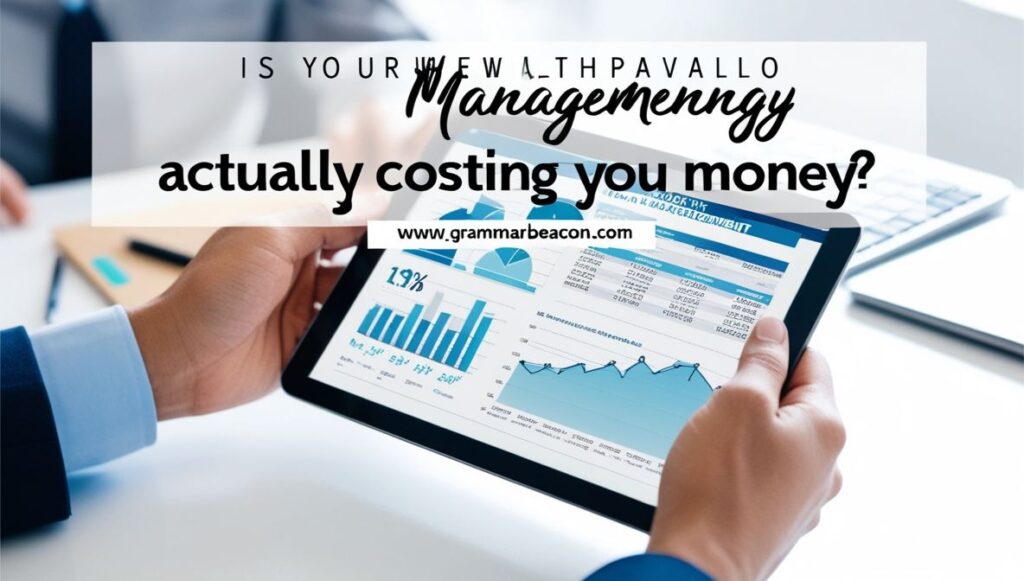When managing your money, your wealth management strategy plays a crucial role in reaching your financial goals. Working with a trusted firm like PedroVazPaulo Wealth Investment offers guidance on asset management, but hidden costs might be reducing your returns. Understanding advisory fees, hidden fees, and portfolio underperformance helps you avoid losing money unknowingly.
Many investors overlook the impact of expense ratios, portfolio turnover, and tax implications on their investments. Effective financial planning includes regular benchmarking investment returns and applying tax-loss harvesting or asset location strategy to improve tax efficiency. This knowledge protects your wealth and helps you build a stronger, more personalized investment plan.
Understanding Wealth Management and Its Costs
Wealth management involves more than investing your money. It includes financial planning, tax efficiency, asset allocation, and ongoing portfolio monitoring. Firms like PedroVazPaulo Wealth Investment manage your assets under management (AUM) with the goal of meeting your financial objectives. However, managing assets comes at a cost.
Advisory fees take the largest share of these costs. Fee-only advisors charge a flat fee or percentage of your assets, offering transparency and reducing conflicts of interest. Commission-based advisors earn from product sales, which can incentivize recommendations that don’t always align with your best interests. Knowing how your financial advisor is compensated lets you evaluate whether your fees are justified.
Hidden Fees: What You Don’t See Costs You
Hidden fees often slip under the radar. Fund expense ratios, trading costs, and administrative fees reduce your portfolio’s value over time. Mutual funds and ETFs have expense ratios that can exceed 1%. Portfolio turnover increases trading commissions and triggers capital gains taxes. Financial advisors may charge fees for tax-loss harvesting or portfolio rebalancing without clear disclosure.
Transparency in wealth management requires your advisor to detail all fees. Reviewing statements and asking for explanations helps uncover hidden costs. PedroVazPaulo Wealth Investment emphasizes clear fee disclosures to help you avoid surprises.
Fee Structures: Comparing Fee-Only, Commission-Based, and Hybrid Models
Advisory fees vary by payment model. Fee-only advisors focus on asset management without product commissions, aligning their success with your portfolio growth. Commission-based advisors earn through sales of financial products, which can create conflicts of interest. Hybrid models mix both approaches, complicating fee transparency.
Understanding your advisor’s compensation helps you avoid paying for unnecessary services or products. Always request a detailed fee breakdown to assess total costs.
Portfolio Underperformance: The True Cost of High Fees
High fees don’t guarantee superior investment performance. Portfolio underperformance compared to benchmarks like the S\&P 500 or balanced indices reduces your wealth. You must evaluate risk-adjusted returns after fees and taxes to judge your financial advisor’s effectiveness.
Underperforming assets and poor allocation cause opportunity cost—money lost by missing better investment choices. Holding cash during market rallies or sticking to underperforming funds hurts your long-term investment growth. Regular portfolio reviews and rebalancing investment portfolios help avoid this.
Tax Efficiency: Minimizing Tax Implications to Protect Returns
Tax efficiency plays a major role in your investment strategy. Tax-advantaged accounts such as Traditional IRA and Roth IRA shelter gains from taxes. Asset location strategy involves placing tax-inefficient assets inside these accounts to reduce annual tax bills.
Tax-loss harvesting offsets capital gains taxes by selling investments at a loss, lowering tax liability. PedroVazPaulo Wealth Investment integrates these strategies into portfolio management to enhance tax efficiency.
Ignoring tax implications leads to higher capital gains tax and lower net returns.
Opportunity Cost: What You’re Losing by Poor Management

Opportunity cost is the potential gains lost due to suboptimal investment choices, high fees, or tax inefficiencies. High portfolio turnover can increase fees and capital gains taxes. Avoiding growth assets during market rallies results in missed investment opportunities.
Compare your portfolio’s returns and allocation with market benchmarks regularly. Your financial advisor should help identify missed opportunities and adjust your investment strategy accordingly.
Reassessing and Optimizing Your Wealth Management Strategy
Your wealth management strategy should evolve with your changing financial goals and market conditions. Signs to reassess include consistent portfolio underperformance, unclear fees, high portfolio turnover, and tax inefficiencies.
To optimize your strategy:
- Request a full advisory fee and hidden fee disclosure
- Benchmark investment performance regularly
- Consider fee-only advisors for transparency
- Implement tax-efficient strategies like tax-loss harvesting and asset location
- Rebalance portfolios to align with risk tolerance
- Evaluate hybrid advisory models carefully for conflicts of interest.
FAQs
Higher advisory fees reduce your net returns, especially over time.
Review annually or when your financial goals change.
Tax efficiency means minimizing taxes on gains to improve overall returns.
Final Thoughts
Your wealth management strategy affects your financial future. Working with PedroVazPaulo Wealth Investment can help you, but only if you understand the costs involved. Hidden fees, poor tax planning, and portfolio underperformance can eat into your returns. Regularly review your strategy and ask clear questions about fees and performance. Choose advisors who focus on your goals, not commissions. A smart wealth management plan reduces costs and improves growth. Stay informed and take control of your investments to protect and grow your wealth over time.

James Logan is a seasoned blogger and language enthusiast behind Grammar Beacon. With years of experience in grammar and writing, James shares his expertise through insightful and engaging content. His passion for clear communication and linguistic precision shines in every post, making complex grammar concepts accessible and enjoyable for readers. Follow James for expert advice and tips to refine your writing skills.







